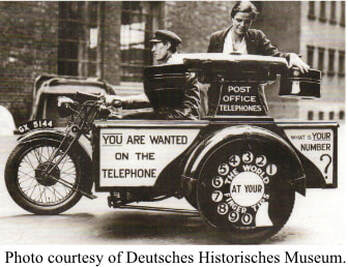
"Hello, Hello;
........Can you hear me, Mother...?"
What's not to like about the humble telephone?
Vintage Communication at its best and it's not going away!
........Can you hear me, Mother...?"
What's not to like about the humble telephone?
Vintage Communication at its best and it's not going away!

Well, here we are in the time of mobile phones, Artificial Intelligence, Blue Tooth and G&Ts.
Dial and the later push-button telephones have been around for a long time now! They have, in many ways, been surpassed by the mobile phone, now found in every high street, bus, train, pub, and many more locations. They may be identified by users colliding with other people, lamp posts or even being run over! People live by their "moby"!
So what has happened to the basic table telephone?
In the old days phone numbers actually related to the name of the district where you lived. My parents, living in Paddington, had the number LADbroke 3454. So you just dialled LAD3454 as the dials had A-Z and numbers. We owned a smart ivory coloured phone with a heavy handset and, in the 1960s, I used to spend ages talking to other friends but it meant (usually) standing next to the phone because it was hard wired into the wall!
During the mid-1980s cordless phones made their appearance; a significant model being the BT "Hawk". These were analogue phones and, in due course, digital cordless became the norm with the "DECT" name.
So.. "WHAT", you might say.
The basic table telephone, whether dial or push-button, is still very relevant today.
Just think about it.
All the other types of communication require either mains or battery power:
Cordless phones need mains electric.
Mobile phones need a good battery which needs to be charged from, guess what, a mains supply!
Basic table telephones requires neither. The telephone network carries its own power and will always work, so if there is an emergency you can always get through to an operator! Should you be relying on mains and there is a power cut, then you are stuffed!
Now, over the years there have been many styles of basic telephones some, of which, have become cult items. The "Bo-Bo" phone is a typical example. But there are many phone designs out there which will become good focal points within your decor and also be genuinely useful if you ever need to make an emergency call!
I remember that when I was in Germany in 1973, you could actually buy a "Telephone Cosy" to match your furnishings!
So please don't dismiss the "Land Line" with associated basic telephone; for one day you may need this valuable access to the outside world!
Dial and the later push-button telephones have been around for a long time now! They have, in many ways, been surpassed by the mobile phone, now found in every high street, bus, train, pub, and many more locations. They may be identified by users colliding with other people, lamp posts or even being run over! People live by their "moby"!
So what has happened to the basic table telephone?
In the old days phone numbers actually related to the name of the district where you lived. My parents, living in Paddington, had the number LADbroke 3454. So you just dialled LAD3454 as the dials had A-Z and numbers. We owned a smart ivory coloured phone with a heavy handset and, in the 1960s, I used to spend ages talking to other friends but it meant (usually) standing next to the phone because it was hard wired into the wall!
During the mid-1980s cordless phones made their appearance; a significant model being the BT "Hawk". These were analogue phones and, in due course, digital cordless became the norm with the "DECT" name.
So.. "WHAT", you might say.
The basic table telephone, whether dial or push-button, is still very relevant today.
Just think about it.
All the other types of communication require either mains or battery power:
Cordless phones need mains electric.
Mobile phones need a good battery which needs to be charged from, guess what, a mains supply!
Basic table telephones requires neither. The telephone network carries its own power and will always work, so if there is an emergency you can always get through to an operator! Should you be relying on mains and there is a power cut, then you are stuffed!
Now, over the years there have been many styles of basic telephones some, of which, have become cult items. The "Bo-Bo" phone is a typical example. But there are many phone designs out there which will become good focal points within your decor and also be genuinely useful if you ever need to make an emergency call!
I remember that when I was in Germany in 1973, you could actually buy a "Telephone Cosy" to match your furnishings!
So please don't dismiss the "Land Line" with associated basic telephone; for one day you may need this valuable access to the outside world!